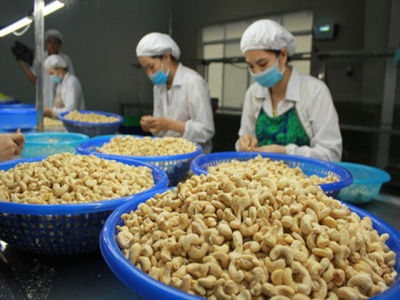Agricultural products seek to sustain export growth amid COVID-19 fears

The novel coronavirus (COVID-19) pandemic has had a strong impact on the export of Vietnamese agricultural products, especially to major markets such as China, the United States, and the European Union.
As such, exporting agricultural products ahead in the remaining months of the year will likely meet numerous difficulties due to unpredictable developments relating to the second wave of the COVID-19 pandemic both locally and globally. In an effort to sustain growth, Vietnam has no choice but to seize upon opportunities from free trade agreements while expanding markets in a flexible manner.
Vietnamese rice records growth
Amid fears surrounding the COVID-19 globally, rice can be considered to be a bright spot in the country’s export picture. The Vietnam Food Association reports that the country’s rice export prices have been continuously increasing since the middle of July and have now even surpassed those of Thailand, one of the world’s leading rice exporters. Most notably, Vietnamese 5% broken rice is being offered at a price of US$20 more than that of the Thai equivalent.
Many rice exporters attribute Vietnam’s high rice export prices to an overall improvement in the quality of rice, a sufficient supply, and quick delivery, despite the complicated COVID-19 pandemic. In addition, the country is benefitting from a bilateral trade deal signed with the European Union, the EU-Vietnam Free Trade Agreement, that offers a 0% tax rate with an annual import quota of 80,000 tonnes of rice.
“This really is a boost to allow Vietnamese rice to enjoy a competitive advantage in the EU,” says Pham Thai Binh, general director of Trung An High-Tech Agriculture Company. “Moreover, Vietnam has many types of fragrant rice recognised as the world’s best such as ST24 and ST25 which are able to compete with similar rice from Thailand and India.”
Sustaining growth
Minister of Agriculture and Rural Development Nguyen Xuan Cuong states that demand for rice, as an essential commodity, along with other agricultural products, will continue to record growth amid the complex nature of the COVID-19 pandemic. Therefore, local firms are advised to find and seize upon opportunities to maintain export growth by diversifying items in order to cater to the diverse tastes of consumers worldwide.
“To increase export value, what businesses need to pay most attention to is to ensure food quality, hygiene, and safety, together with traceability, especially for high-quality rice,” Cuong stresses.
As Vietnam’s largest goods consumer, China recently tightened its control of imports, including conducting a review of the origins and quality of imported products in an effort to limit the spread of the COVID-19.
In response, the Ministry of Industry and Trade has recommended that both producers and processors strengthen their quality supervision, proactively coordinate efforts with importers in a bid to strictly comply with regulations relating to quality standards, food safety, and traceability.
Simultaneously, firms must get market updates and keep a close watch on Chinese policy changes in order to have a viable strategy for transporting commodities to border checkpoints, so as to help minimise risks and reduce the time for goods clearance at border gates.
Market developments under scrutiny
According to experts, the world will likely witness unpredictable developments during the course of the remaining months of the year as a result of the impact of the COVID-19 pandemic, trade disputes, and geopolitical tensions occurring in a number of regions. In addition, it is becoming a trend to protect domestic production, while many importers are starting to tighten technical barriers and impose trade safeguard measures.
Deputy Minister of Industry and Trade Do Thang Hai states that agricultural exports will improve despite difficulties set to occur between now and the end of the year. Therefore, the ministry will work closely alongside the Ministry of Agriculture and Rural Development, various agencies, and enterprises to closely monitor market changes, the supply and demand of essential agricultural products locally to ensure food security, as well as to maintain exports. The ministry will also provide frequent updates on development in key markets affected by the COVID-19 in order to devise a prompt response.
“The two ministries will focus on removing technical barriers, while seeking to expand the market to the European Union, the Eurasian Economic Union, and the US,” Deputy Minister Hai notes.
The Ministry of Industry and Trade reports that despite the impact of COVID-19, the country enjoyed a trade surplus of approximately US$5.2 billion from January to July, a rise of 3.8% compared to the same period in 2019. Staples such as rice, vegetables, cassava, and shrimp maintained high-export growth, with the value higher compared to last year’s corresponding period.
Có thể bạn quan tâm
 Vietnamese rice exports enjoy strong growth despite Covid-19
Vietnamese rice exports enjoy strong growth despite Covid-19 While many of Vietnamese agricultural exports have faced Covid-19 threat, rice exports during seven months of 2020 increased by 10.9% in value
 Rice exports enjoy robust growth despite COVID-19 threat
Rice exports enjoy robust growth despite COVID-19 threat While many of Vietnamese agricultural exports have faced COVID-19 challenges, rice exports during the opening seven months of the year increased by 10.9%
 Organic farming helps small businesses grow
Organic farming helps small businesses grow As demand for healthy food grows, one farmer in the Phú Yên Province has decided to go organic.